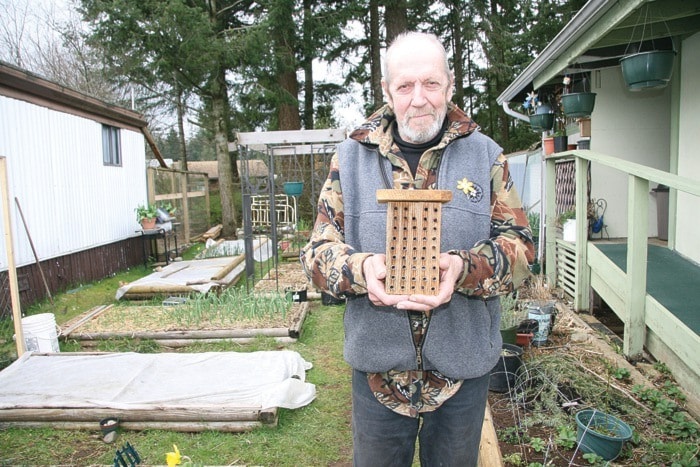Jim Dubois intends on leaving this world a more colourful place.
Greener, redder, pinker, all the colours within the rainbow, and all in his little garden.
“I practice square-inch gardening,” he says with a nod towards the green zone between his trailer and the neighbour’s, “if there’s a hole, you put something in it.”
He and his partner Linda are still munching on last year’s produce, neatly frozen after harvest, while any extras were given away to the neighbours.
Carrots, peppers, tomatoes, Swiss chard, peas, beans, strawberries, garlic – lots of garlic – and a variety of other vegetables thrive in the raised beds of the green zone. The veggies and flowers thrive because they’re full of home-churned compost and nitrogen-rich kelp.
“I like it best when it starts to turn a little black,” he says of the kelp he collects after it washes up and starts to rot on the beach in Oyster Bay.
But there’s something more to the intricate garden ecosystem which keeps it buzzing: Mason bees.
They’re Dubois’ little helpers. “Perfect pollinators” he calls them and Dubois does his best to make them feel comfortable.
“I build homes for them. Usually two in the winter and I give one away,” he says with a smile.
Mason bees are different than hive bees. They’re known as “solitary but gregarious nesters” which means they nest close to each other, but each female provisions her own nest.
Dubois builds their nests out of small blocks of wood, drilled with holes which creates narrow, little homes for the bees. He is also experimenting by placing pieces of plastic straws in each hole, which should allow for easier cleaning once the eggs hatch and the bees leave home.
And once they leave, they become, well, as busy as bees. The only goal of the males is – don’t snicker – to reproduce with as many females as possible and then die.
It’s the females who are the true workers as they gather extraordinary amounts of pollen which they return to the nest to create balls of feed for their unhatched eggs (they don’t make honey). It is estimated, that Masons out-pollinate honey bees from rates of 20:1 to as high as 100:1.
They also stick close to home which makes them ideal for pollinating fruit trees. As well, Mason bees emerge from their nests earlier in the springtime than most other bees, sometimes too early.
“I found one out the other day, but it was lousy weather,” says Dubois, who gently picked it up and placed it near one of the many homes in his yard, under the shelter of a plastic planter.
Mason bees are also less prickly than other bees. In the 12 years he’s been keeping them, Dubois has been stung just once. He figures he was tossing some old blooms into the compost and accidentally squeezed a small bee between his fingers. Naturally, it stung him.
“Have you ever put a nine-volt battery to your tongue? It felt like that,” says Dubois, who points out the non-aggressive Mason bees do not have a venom gland.
The biggest challenge facing Mason bees, he says, is habitat destruction and death from chemical poisoning, usually pesticides. That’s why he builds homes for the bees and keeps his garden naturally organic.
Keeping the bees healthy is important to Dubois, 65, who has also battled for survival. In 2008, he received a new lease on life when he received a lung transplant due to a degenerative disease.
“This is just bonus time,” says Dubois, who is also a talented nature photographer. “I believe in ‘paying it forward,’ especially after the transplant. Pollinators are so important and it’s easy to help them…(Mason bees) are real gentle little things and they’re great for helping anyone to break out of their bee-phobia.”
- Dubois will display his Mason bee nests and some of his photographs on Wednesday, April 20, 5-7:30 p.m., in the Tidemark Theatre lobby during the Earth Week celebration.
